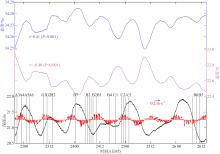| [1] |
陈希荣, 朱佳, 孙振宇, 等, 2018. 2015年7—8月珠江冲淡水扩展特征的观测与分析[J]. 厦门大学学报(自然科学版), 57(6): 841-848.
|
|
CHEN XIRONG, ZHU JIA, SUN ZHENYU, et al, 2018. Observation and analysis of the extension characteristics of the Pearl River Diluted Water from July to August in 2015[J]. Journal of Xiamen University (Natural Science), 57(6): 841-848 (in Chinese with English abstract).
|
| [2] |
林卫强, 李适宇, 2002. 夏季伶仃洋COD、DO的垂向分布及其影响因素[J]. 中山大学学报(自然科学版), 41(4): 82-86.
|
|
LIN WEIQIANG, LI SHIYU, 2002. Vertical distribution of COD and DO and its affecting factors in the Pearl River Estuary in summer[J]. Acta Scientiarum Naturalium Universitatis Sunyatseni, 41(4): 82-86 (in Chinese with English abstract).
|
| [3] |
林祖亨, 梁舜华, 1996. 珠江口水域的潮流分析[J]. 海洋通报, 15(2): 11-22.
|
|
LIN ZUHENG, LIANG SHUNHUA, 1996. A study on the tidal currents in the waters of the Pearl River Mouth[J]. Marine Science Bulletin, 15(2): 11-22 (in Chinese with English abstract).
|
| [4] |
毛汉礼, 甘子钧, 蓝淑芳, 1963. 长江冲淡水及其混合问题的初步探讨[J]. 海洋与湖沼, 5(3): 183-206.
|
|
MAO HANLI, KAN T, LAN SHUFANG, 1963. A preliminary study of the Yangtze Diluted Water and its mixing processes[J]. Oceanologia Et Limnologia Sinica, 5(3): 183-206 (in Chinese with English abstract).
|
| [5] |
宋晓飞, 石荣贵, 孙羚晏, 等, 2014. 珠江口磨刀门盐水入侵的现状与成因分析[J]. 海洋通报, 33(1): 7-15.
|
|
SONG XIAOFEI, SHI RONGGUI, SUN LINGYAN, et al, 2014. Status and cause of saltwater intrusion in Modaomen, Pearl River Estuary[J]. Marine Science Bulletin, 33(1): 7-15 (in Chinese with English abstract).
|
| [6] |
伍伯瑜, 1990. 珠江口以西陆架海域环流研究Ⅲ[J]. 台湾海峡, 9(2): 118-126.
|
|
WU BOYU, 1990. A study on the circulation in shelf waters west to Zhujiang River mouth Ⅲ. Shelf circulation model[J]. Journal of Oceanography in Taiwan Strait, 9(2): 118-126 (in Chinese with English abstract).
|
| [7] |
夏华永, 刘长建, 王东晓, 2018. 2006年夏季珠江冲淡水驱动的上升流[J]. 海洋学报, 40(7): 43-54.
|
|
XIA HUAYONG, LIU CHANGJIAN, WANG DONGXIAO, 2018. The upwelling driven by the Zhujiang River runoff in 2006 summer[J]. Haiyang Xuebao, 40(7): 43-54 (in Chinese with English abstract).
|
| [8] |
夏维, 周争桥, 2021. 基于观测资料的珠江口附近海域夏季气象水文要素分析[J]. 海洋湖沼通报, 43(5): 60-65.
|
|
XIA WEI, ZHOU ZHENGQIAO, 2021. Analysis of meteorological and hydrological elements in the sea around the Pearl River Estuary based on observed data in summer[J]. Transactions of Oceanology and Limnology, 43(5): 60-65 (in Chinese with English abstract).
|
| [9] |
杨威, 罗琳, 高永利, 等, 2011. 1999年和2009年夏季珠江口环境要素的对比与分析[J]. 热带海洋学报, 30(4): 16-23.
|
|
YANG WEI, LUO LIN, GAO YONGLI, et al, 2011. Comparison of environmental constituents in the Pearl River Estuary during summer of 1999 and 2009[J]. Journal of Tropical Oceanography, 30(4): 16-23 (in Chinese with English abstract).
|
| [10] |
曾淦宁, 胡建宇, 洪华生, 等, 2005. 西南季风不同阶段南海北部珠江口外断面水文调查分析[J]. 热带海洋学报, 24(3): 10-17.
|
|
ZENG GANNING, HU JIANYU, HONG HUASHENG, et al, 2005. Analysis of hydrologic section off Zhujiang River Estuary in northern South China Sea during various southwest Monsoon phases[J]. Journal of Tropical Oceanography, 24(3): 10-17 (in Chinese with English abstract).
|
| [11] |
章文, 刘丙军, 陈晓宏, 等, 2013. 珠江口磨刀门水道盐度变化与潮汐过程的相关性分析[J]. 中山大学学报(自然科学版), 52(6): 11-16.
|
|
ZHANG WEN, LIU BINGJUN, CHEN XIAOHONG, et al, 2013. Correlations between salinity and tidal process in Modaomen waterway of the Pearl River Estuary[J]. Acta Scientiarum Naturalium Universitatis Sunyatseni, 52(6): 11-16 (in Chinese with English abstract).
|
| [12] |
张燕, 夏华永, 钱立兵, 等, 2011. 2006年夏、冬季珠江口附近海域水文特征调查分析[J]. 热带海洋学报, 30(1): 20-28.
|
|
ZHANG YAN, XIA HUAYONG, QIAN LIBING, et al, 2011. Analysis on hydrological characteristics off the Pearl River Estuary in summer and winter of 2006[J]. Journal of Tropical Oceanography, 30(1): 20-28 (in Chinese with English abstract).
|
| [13] |
赵焕庭, 1990. 珠江河口演变[M]. 北京: 海洋出版社: 116-147 (in Chinese).
|
| [14] |
朱佳, 胡建宇, 陈照章, 等, 2005. 珠江口以外海域温、盐度的断面分布特征———2001年5月与2002年11月航次[J]. 厦门大学学报(自然科学版), 44(5): 680-683.
|
|
ZHU JIA, HU JIANYU, CHEN ZHAOZHANG, et al, 2005. Analysis on sectional characteristics of temperature and salinity off the Zhujiang River Estuary-During the cruises of May 2001 and November 2002[J]. Journal of Xiamen University (Natural Science), 44(5): 680-683 (in Chinese with English abstract).
|
| [15] |
CHEN XIRONG, SUN ZHENYU, LIN HONGYANG, et al, 2019. Analysis of temperature inversion in the Zhujiang River Estuary in July 2015[J]. Acta Oceanologica Sinica, 38(4): 167-174.
|
| [16] |
DONG LIXIAN, SU JILAN, WONG L A, et al, 2004. Seasonal variation and dynamics of the Pearl River plume[J]. Continental Shelf Research, 24(16): 1761-1777.
|
| [17] |
GAN JIANPING, LI LI, WANG DONGXIAO, et al, 2009. Interaction of a river plume with coastal upwelling in the northeastern South China Sea[J]. Continental Shelf Research, 29(4): 728-740.
|
| [18] |
MAO QINGWEN, SHI PING, YIN KEDONG, et al, 2004. Tides and tidal currents in the Pearl River Estuary[J]. Continental Shelf Research, 24(16): 1797-1808.
|
| [19] |
ZHAI WEIDONG, DAI MINHAN, CAI WEIJUN, et al, 2005. High partial pressure of CO2 and its maintaining mechanism in a subtropical estuary: the Pearl River Estuary, China[J]. Marine Chemistry, 93(1): 21-32.
|
 ), 张小波1, 常景龙1, 张守文1, 季轩梁2, 苗润乔1, 李建东1, 朱学明1(
), 张小波1, 常景龙1, 张守文1, 季轩梁2, 苗润乔1, 李建东1, 朱学明1( )
)
 ), ZHANG Xiaobo1, CHANG Jinglong1, ZHANG Shouwen1, JI Xuanliang2, MIAO Runqiao1, LI Jiandong1, ZHU Xueming1(
), ZHANG Xiaobo1, CHANG Jinglong1, ZHANG Shouwen1, JI Xuanliang2, MIAO Runqiao1, LI Jiandong1, ZHU Xueming1( )
)



























